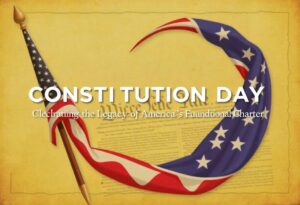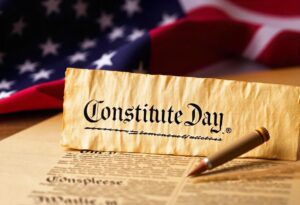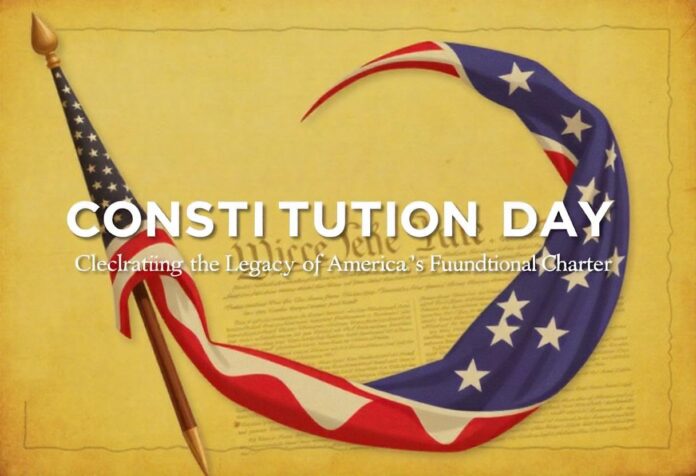Constitution Day
Every year on September 17th, the United States takes a moment to celebrate Constitution Day, marking the anniversary of the signing of the U.S. Constitution in 1787. This pivotal document has not only shaped the nation’s governance but also laid the groundwork for democracy and individual freedoms that Americans cherish today. Let’s dive into the significance of this day, how it’s celebrated, and why the Constitution remains a cornerstone of American society.

Historical Significance
On a historic day in Philadelphia, 39 delegates signed the U.S. Constitution, setting the stage for a new era in American governance. This document outlined the framework of the federal government and established the system of checks and balances that continues to guide the nation. Constitution Day serves as a reminder of this monumental event and the foresight of the Founding Fathers in creating a living document that could adapt to the changing times.
it’s September 17, 1787. The room is tense, the stakes are high, and history is being written—literally. That’s the day the U.S. Constitution was signed, setting the stage for American democracy as we know it. Fast forward to today, and we celebrate this monumental occasion with Constitution Day. But why should a document over 230 years old matter to us now? Grab a cup of coffee, settle in, and let’s explore the significance of Constitution Day and its enduring legacy.
The Historical Significance of September 17, 1787
The date September 17, 1787, might not be on everyone’s radar, but it should be. On this day, 39 brave delegates from 12 states (sorry, Rhode Island) gathered in Philadelphia to sign the U.S. Constitution. This wasn’t just any document; it was a blueprint for a new nation. It laid out the framework for governance, detailing the separation of powers, checks and balances, and the federal system that we often take for granted today.
The Constitution was born out of necessity. The Articles of Confederation, which had loosely held the states together after independence, were failing. The founders needed something robust enough to unite the young republic while allowing for individual freedoms. And voila, the Constitution was drafted in a little over four months. Think about that next time you procrastinate on a project!

Celebrations and Events
Today, Constitution Day isn’t just a date on a history teacher’s syllabus; it’s an event! Across the country, organizations and schools celebrate with various activities to honour the signing of this ground-breaking document. Educational programs and public readings of the Constitution bring communities together, instilling a sense of pride and understanding.
Museums often roll out special exhibitions showcasing original documents, historical artifacts, and interactive displays. These programs are not just for history buffs but are designed to engage younger generations, making the past come alive through technology and storytelling. Participating in these events can make you feel like you’re part of a historical re-enactment, minus the powdered wigs.
The Constitution’s Impact on American Democracy
The U.S. Constitution is more than just words on parchment; it’s a living, breathing framework that has guided American democracy since its inception. It established the three branches of government—executive, legislative, and judicial—ensuring no single entity could dominate the political landscape.

One of the most significant contributions of the Constitution is the Bill of Rights, added in 1791. These first ten amendments guarantee fundamental rights and freedoms like freedom of speech, religion, and the press. They also ensure fair legal processes, protecting citizens from government overreach.
“The U.S. Constitution is a testament to the foresight of our founding fathers, who crafted a document that remains the cornerstone of our democracy,” says [Historical Scholar Name]. This foresight has allowed the Constitution to adapt over time, addressing issues like civil rights, women’s suffrage, and more.
Citizenship and Civic Engagement
Constitution Day is also Citizenship Day, recognizing the responsibilities and privileges that come with being a citizen. It’s a fantastic opportunity to encourage civic participation, reminding people that democracy isn’t a spectator sport; it’s a team effort.
Understanding your rights and responsibilities as outlined in the Constitution can empower you to participate more fully in civic life. Voting, jury duty, and even peaceful protests are ways to engage in the democratic process. “Constitution Day serves as a reminder that our rights and responsibilities as citizens are rooted in the principles outlined in this enduring document,” says [Civic Educator Name].
Modern Relevance of the Constitution
You might wonder, how does a document written in the 18th century remain relevant today? The answer lies in its flexibility and adaptability. The Constitution is sometimes referred to as a “living document,” capable of evolving with society’s changing needs.
Take, for instance, current debates on issues like digital privacy, healthcare, and climate change. These were unimaginable topics in 1787, yet the Constitution provides a framework for addressing them. “The Constitution is a living document, evolving with our society to ensure that our government remains of, by, and for the people,” notes [Legal Expert Name].
Even today, Supreme Court rulings continue to interpret the Constitution, providing new understandings of its clauses and their applications. This ongoing dialogue between the past and the present ensures that the Constitution remains dynamic and relevant.
Key Sections of the U.S. Constitution You Should Know
The Preamble
The Preamble sets the stage, outlining the Constitution’s purpose. It’s the “We the People” part you probably memorized in school. It establishes the foundational goals of justice, tranquillity, defines, welfare, and liberty.
The Articles
There are seven articles in the Constitution. These articles lay out the structure of the government:
- Article I focuses on the legislative branch, detailing the powers of Congress.
- Article II outlines the executive branch, including the presidency.
- Article III establishes the judicial branch, including the Supreme Court.
- Articles IV-VII cover everything from state interactions to the amendment process, federal power, and the ratification process.
The Amendments
The Constitution has 27 amendments, the first ten of which are known as the Bill of Rights. These amendments address essential freedoms and legal protections and allow the document to adapt to societal changes.
Fun Facts About the U.S. Constitution
- Shortest and Longest: The U.S. Constitution is the shortest written constitution of any major government in the world. Yet, it has the broadest reach.
- Original Copies: Only 13 original copies of the Constitution exist. One is at the National Archives in Washington, D.C.
- Benjamin Franklin’s Role: At 81, Benjamin Franklin was the oldest delegate at the Constitutional Convention. He had to be carried to sessions in a sedan chair due to his poor health, yet he played a crucial role in the debates.
How to Engage With Constitution Day
Attend Local Events
Check out local museums, libraries, and community canters for Constitution Day events. Many offer free admission or special programs designed to educate and entertain.
Participate in Online Activities
Can’t make it to an in-person event? No problem! Many organizations stream live readings, host webinars, and offer virtual tours. You can participate in discussions and learn from experts without leaving your home.
Teach the Next Generation
If you’re a parent or educator, use Constitution Day as a teaching moment. Engage kids with fun activities, videos, and interactive lessons that make history come alive.
Reflect on Your Rights and Duties
Take a few moments to read the Constitution. Reflect on what it means to you and how it impacts your daily life. Consider how you can be more active in your civic duties and contribute to the democratic process.
Conclusion
Constitution Day isn’t just a nod to the past; it’s a celebration of a living document that continues to shape and guide the United States. From establishing the groundwork for democracy to adapting to modern challenges, the Constitution remains a beacon of hope and resilience. “Understanding the Constitution is not just a duty but a privilege. It empowers us to protect the very freedoms it guarantees,” reminds [Historical Figure or Notable Political Leader].
By engaging with Constitution Day through local events, educational programs, and personal reflection, you become part of a tradition that values knowledge, civic responsibility, and the power of “We the People.” Whether you’re a history buff, civic educator, or American patriot, there’s no better time to celebrate the enduring legacy of America’s foundational charter.
Stay curious, stay engaged, and keep celebrating the Constitution—today and every day!
External Resources
To expand your understanding and appreciation of the Constitution, here are some engaging resources to explore:
- National Archives – America’s Founding Documents: Dive into the original texts and learn about the history and significance of the Constitution.
- Constitution Center: Offers interactive exhibits, engaging educational materials, and fascinating constitutional history podcasts.
- Library of Congress: Access a plethora of teaching resources, primary documents, and virtual tours that bring the Constitution to life.
- CrashCourse on YouTube: Check out the “U.S. Government and Politics” series for lively and informative videos about the Constitution.
- iCivics: Founded by Justice Sandra Day O’Connor, this platform offers interactive games and resources that make learning about civics fun and engaging for students.
These resources provide diverse perspectives and tools to deepen your engagement with the Constitution, whether you’re a student, educator, or simply a curious citizen.
For those hungry for more insights into the latest happenings and societal trends, don’t miss out on checking FitBizHouse’s Current Affairs Section. It’s a lively repository of articles and discussions that keeps you in the loop with the world around you—perfect for the curious minds eager to stay informed and engaged!


